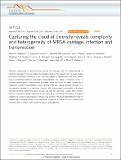Files in this item
Capturing the cloud of diversity reveals complexity and heterogeneity of MRSA carriage, infection and transmission
Item metadata
| dc.contributor.author | Paterson, Gavin K | |
| dc.contributor.author | Harrison, Ewan M | |
| dc.contributor.author | Murray, Gemma G R | |
| dc.contributor.author | Welch, John J | |
| dc.contributor.author | Warland, James H | |
| dc.contributor.author | Holden, Matthew T G | |
| dc.contributor.author | Morgan, Fiona J E | |
| dc.contributor.author | Ba, Xiaoliang | |
| dc.contributor.author | Koop, Gerrit | |
| dc.contributor.author | Harris, Simon R | |
| dc.contributor.author | Maskell, Duncan J | |
| dc.contributor.author | Peacock, Sharon J | |
| dc.contributor.author | Herrtage, Michael E | |
| dc.contributor.author | Parkhill, Julian | |
| dc.contributor.author | Holmes, Mark A | |
| dc.date.accessioned | 2015-04-10T11:31:04Z | |
| dc.date.available | 2015-04-10T11:31:04Z | |
| dc.date.issued | 2015-03-27 | |
| dc.identifier | 178073891 | |
| dc.identifier | 5794b8e5-0377-4a96-bf01-b4e6d0eac570 | |
| dc.identifier | 25814293 | |
| dc.identifier | 84925610368 | |
| dc.identifier.citation | Paterson , G K , Harrison , E M , Murray , G G R , Welch , J J , Warland , J H , Holden , M T G , Morgan , F J E , Ba , X , Koop , G , Harris , S R , Maskell , D J , Peacock , S J , Herrtage , M E , Parkhill , J & Holmes , M A 2015 , ' Capturing the cloud of diversity reveals complexity and heterogeneity of MRSA carriage, infection and transmission ' , Nature Communications , vol. 6 , 6560 . https://doi.org/10.1038/ncomms7560 | en |
| dc.identifier.issn | 2041-1723 | |
| dc.identifier.other | ORCID: /0000-0002-4958-2166/work/60196504 | |
| dc.identifier.uri | https://hdl.handle.net/10023/6470 | |
| dc.description | Funding: M.T.G.H., S.R.H. and J.P. were funded by Wellcome Trust grant no. 098051. | en |
| dc.description.abstract | Genome sequencing is revolutionizing clinical microbiology and our understanding of infectious diseases. Previous studies have largely relied on the sequencing of a single isolate from each individual. However, it is not clear what degree of bacterial diversity exists within, and is transmitted between individuals. Understanding this 'cloud of diversity' is key to accurate identification of transmission pathways. Here, we report the deep sequencing of methicillin-resistant Staphylococcus aureus among staff and animal patients involved in a transmission network at a veterinary hospital. We demonstrate considerable within-host diversity and that within-host diversity may rise and fall over time. Isolates from invasive disease contained multiple mutations in the same genes, including inactivation of a global regulator of virulence and changes in phage copy number. This study highlights the need for sequencing of multiple isolates from individuals to gain an accurate picture of transmission networks and to further understand the basis of pathogenesis. | |
| dc.format.extent | 10 | |
| dc.format.extent | 2173962 | |
| dc.language.iso | eng | |
| dc.relation.ispartof | Nature Communications | en |
| dc.subject | R Medicine | en |
| dc.subject | DAS | en |
| dc.subject | SDG 3 - Good Health and Well-being | en |
| dc.subject.lcc | R | en |
| dc.title | Capturing the cloud of diversity reveals complexity and heterogeneity of MRSA carriage, infection and transmission | en |
| dc.type | Journal article | en |
| dc.contributor.institution | University of St Andrews. School of Medicine | en |
| dc.contributor.institution | University of St Andrews. Infection Group | en |
| dc.contributor.institution | University of St Andrews. Biomedical Sciences Research Complex | en |
| dc.identifier.doi | https://doi.org/10.1038/ncomms7560 | |
| dc.description.status | Peer reviewed | en |
This item appears in the following Collection(s)
Items in the St Andrews Research Repository are protected by copyright, with all rights reserved, unless otherwise indicated.

